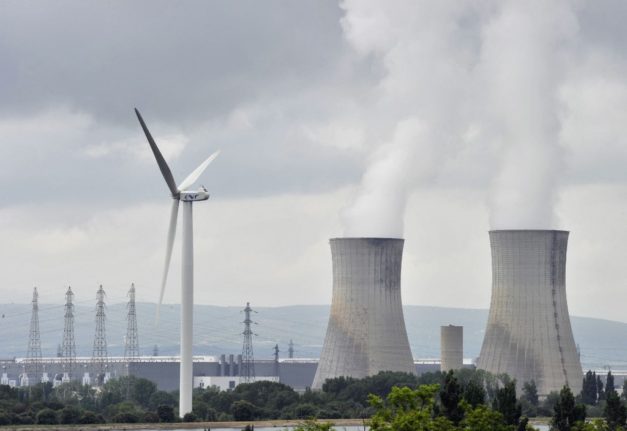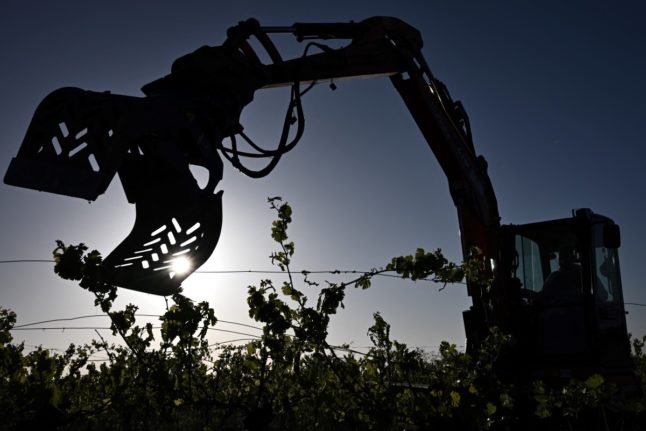Nearly three-quarters of France’s energy is supplied by a combination of nuclear power and hydro-electric power, according to Agence ORE (Opérateurs de Réseaux d’Énergie), a group made up of all of the country’s electricity and gas distributors.
Its figures reveal nuclear power supplies 63 percent of France’s energy needs, while hydro-electric operations – which provided a vital energy bulwark against the possibility of blackouts in the winter – supplies a further 11 percent.
But both of those technologies are extremely vulnerable to drought.
READ ALSO Water limits, apps and leaks: How France plans to deal with future droughts
The summer of 2022 in France was marked by scorching temperatures and record droughts and the unusually dry winter has failed to recharge groundwater supplies. Such events are predicted to become more and more common in the years ahead due to the climate crisis.
The problems that drought causes for hydro-electric power are self-explanatory, but low water levels are also a problem for nuclear power plants.
Nuclear
When France was hit by an early heat wave in May last year, EDF slowed down one of the reactors at a power plant on the banks of the Garonne for a few hours, so that less of the hot water – used to cool nuclear fuel in the reactor – would be released into the river. In June 2022, a plant on the Rhône did the same. These operations are not unusual, but they usually occur later in the summer.
READ ALSO ‘Uncharted territory’: Europe faces more deadly droughts and extreme heat
In July and August the Bugey, Blayais, Golfech, Saint-Alban and Tricastin plants were granted waivers to exceed regulatory limits on the temperature of water – established to protect the fauna and flora and the functioning of the river ecosystem – discharged into rivers.
Global warming is set to increase the duration of these droughts and heatwaves, which will affect France’s river levels as demand for electricity soars to power computers, electric vehicles, heat pumps and so on. With river levels lower, and greater demand, it is increasingly likely that more dangerously hot water will be released into French rivers.
Hydro
Hydro-electric energy is currently France’s main source of renewable electricity – and it is particularly susceptible to drought. Last summer’s long and punishing drought means annual hydroelectric production to plunge to its lowest level since 1976 – at 49.6 TWh, according to RTE – down some 20 percent on the 2014-2019 average.
In the event of severe drought, less power is produced because the flow of water – the fuel for hydro-electric energy – is lower. And a lack of snow and rain in winter means that reservoirs are not refilled as well.
In its 2022 report, RTE said “stocks reached historically low levels in mid-July”, before returning to “average levels” in autumn. Even so, hydro-electric power was recognised in Parliament as having helped save France from feared power outages over the winter.
Electricity usage
Network operator RTE has forecast that electricity consumption will increase from 459.3 TWh in 2022 to a range of 555 to 745 TWh by 2050.
The question is whether renewable energy supply and next-generation nuclear power stations can keep up with demand.
Experts are not convinced, and have suggested the switch to greener, renewable power should go hand in hand with greater emphasis on individual energy responsibility.
France is not new to the idea of sobriété énergétique (energy saving). Over winter, following the Russian invasion of Ukraine, France urged public officials, businesses and individuals to cut electricity use.
READ ALSO MAP: How France cut its electricity use by 10% this winter
Many of the rules imposed – such as shops cutting power to outdoor signage at night, and keeping their doors closed to save energy – are set to remain as part of the country’s ambitious target to cut its total energy use by 30 percent by 2040.
Then, in March, President Emmanuel Macron announced plans for how France will be able to reduce water usage – with a 10 percent cut in demand sought by 2030.
READ ALSO MAP: Where in France is under water restrictions in spring 2023?
Similar to the plan for energy savings during winter 2022 – when France managed to reduce electricity consumption by around nine percent over the winter – the water saving plan will be implemented sector by sector – meaning that the energy, tourism, agriculture and heavy industry sectors (including nuclear) will be asked to come up with specific plans to decrease water consumption.
Experts say that all renewable energy will be constrained by climatic conditions – a lack of wind, heat, drought are all going to affect production.
Although the immediate risks of power blackouts due to heatwaves and drought are considered low – “not in this decade, anyway”, Nicolas Goldberg, energy market expert for the firm Colombus Consulting, told franceinfo – that does not mean efforts to find solutions should be kicked down the road.



 Please whitelist us to continue reading.
Please whitelist us to continue reading.
Member comments